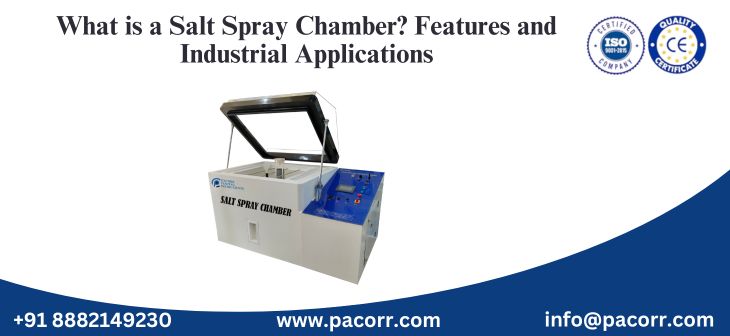
Pacorr’s salt spray chamber is a precision instrument engineered to simulate and accelerate corrosive environments for rigorous evaluation of metals, coatings, and assembled components. By generating a controlled salt fog atmosphere, this equipment enables manufacturers to predict long-term performance, validate protective treatments, and comply with international corrosion testing standards.
Understanding Salt Spray Testing Principles
Salt spray testing reproduces the effects of marine and industrial atmospheres by atomizing a sodium chloride solution into a fine mist. Key test parameters include:
- Solution Concentration: A 5 percent by-weight sodium chloride solution mimics sea water salinity
- Temperature Control: Maintaining 35 °C ± 1 °C ensures consistent reaction kinetics
- pH Stability: Adjusting solution pH to 6.5–7.2 prevents acid- or base-driven anomalies
- Spray Rate: 1.5–2.5 mL per 80 cm² per hour delivers uniform fog density
These factors converge to condense years of field exposure into days or weeks of laboratory testing, delivering actionable insights into corrosion resistance.
Core Components and Operation Workflow
Specimen Preparation and Mounting
- Surface Cleaning
- Degrease parts with acetone or isopropyl alcohol
- Ensure no residual contaminants that could alter corrosion pathways
- Mounting Fixtures
- Position samples at a 20-degree incline to facilitate condensate runoff
- Avoid sample overlap to guarantee uniform exposure
Salt Fog Generation
An atomizing nozzle sprays the salt solution using filtered compressed air. The resulting fine mist circulates through the chamber, maintained at set temperature and relative humidity. Digital feedback loops continuously adjust heater and spray pump output to adhere to test profile.
Test Cycles and Durations
- Continuous Fog Testing: Uninterrupted exposure for baseline corrosion resistance
- Cyclic Corrosion Testing: Alternating periods of dry, humid, and salt fog conditions to mimic real-world fluctuations
- Humidity Cabinet Mode: Sustained high humidity without direct spray for specialized coatings
Typical cycle lengths range from 24 hours to 1,000 hours, depending on coating complexity and industry benchmarks.
Advanced Features of Modern Salt Spray Chambers
Digital Control and Data Logging
Integrated PLC controllers allow operators to program up to 20 distinct test profiles. Real-time data logging captures temperature, spray pressure, and solution volume, exporting CSV reports for compliance audits.
Corrosion-Resistant Construction
Interior liners are fabricated from UV-stabilized PVC or high-density polypropylene, while external panels use epoxy-coated steel for mechanical strength. All wetted components employ non-metallic seals to eliminate galvanic interactions.
Safety and Compliance
- Overpressure Relief Valves: Prevent chamber rupture by venting excess pressure
- Automatic Shutoff: Stops fog generation if solution reservoir runs dry
- Alarm Notifications: Visual and audible alerts for deviations in set points
Why Partner with a salt spray chambr manufacturer
Selecting an experienced salt spray chambr manufacturer ensures access to:
- Expert Engineering Support: Guidance on test method selection, chamber sizing, and validation protocols
- Custom Configurations: Tailored chamber volumes, fixture designs, and software interfaces
- Ongoing Calibration Services: Certified recalibration of temperature sensors and spray pumps to maintain test integrity
A reputable manufacturer also provides full documentation, including factory calibration certificates and traceable component specifications.
Industrial Applications and Case Studies
Automotive Coating Validation
Pacorr systems test painted bumpers, wheel hubs, and fastener assemblies for 500+ hours without visible substrate corrosion. Data from these tests inform paint formulation adjustments, reducing field failures by 30 percent.
Aerospace Alloy Qualification
Nickel-based superalloys and anodized aluminum components undergo simulated salt fog and humidity cycles to meet AMS and MIL-STD requirements. Test reports include micrograph analysis of oxide layer formation and delamination resistance.
Marine Hardware Endurance
Deck fittings, cleats, and mooring shackles are evaluated under extended fog exposure. Results guide material selections—such as duplex stainless steels versus standard 316L—to optimize lifecycle costs and maintenance intervals.
Electronics Enclosure Sealing
Outdoor telecom cabinets and marine navigation equipment are subjected to combined salt fog and condensation tests. Successful trials demonstrate IP66 compliance and prevent corrosion-induced electrical failures.
Renewable Energy Components
Wind turbine pitch bearings and solar tracker mounts endure cyclic corrosion tests replicating offshore conditions. Long-term data projections support 20-year performance guarantees.
Best Practices for Reliable Corrosion Testing
- Routine Calibration
- Schedule sensor calibration every six months
- Maintain calibration certificates for regulatory audits
- Solution Management
- Verify salt concentration with refractometry before each test
- Replace solution weekly to avoid pH drift and biological growth
- Standardized Cleaning Protocols
- Document solvent types, exposure times, and drying procedures
- Include control samples to detect procedural inconsistencies
- Detailed Reporting
- Capture high-resolution images of corrosion sites
- Record all environmental parameters, sample IDs, and test deviations
Maximizing ROI with Salt Spray Testing
By integrating salt spray testing into your quality assurance program, you can:
- Detect Early-Stage Failures: Identify coating flaws, substrate impurities, or design weaknesses before market release
- Reduce Warranty Claims: Mitigate field corrosion issues that lead to costly recalls and reputation damage
- Optimize Material Selection: Compare alloys, coatings, and surface treatments under identical test conditions
- Support Marketing Claims: Use third-party certified test data to substantiate product durability guarantees
Conclusion
A salt spray chamber is more than a testing device—it is a cornerstone of every robust corrosion management strategy. With precise environmental controls, programmable test cycles, and comprehensive safety features, Pacorr’s salt spray chambers empower engineers to accelerate product development, validate materials, and uphold the highest standards of quality. Choosing a trusted salt spray chambr manufacturer ensures your laboratory remains at the forefront of corrosion testing technology, delivering reliable data that underpins experience, expertise, authoritativeness, and trustworthiness in every industry application.
Thanks to Pacorr Testing instruments, we have all the required quality testing instruments that have helped us to ensure the best quality delivered to our clients.

Danish
Fair Exports Pvt. Ltd.

